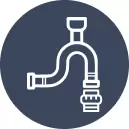Water features refer to areas in the garden that are integrated with water as the primary design element. They may comprise flowing water, stagnant water, or splashing water. These characteristics are common to both residential and commercial environments. They can be large or small and can turn a yard into a more attractive and pleasant outdoor space.
Why Water Features Are Popular
Water is one of the top choices because it tends to enhance the aesthetics and feel of outdoor spaces. They tend to be the focal point of a garden and they serve many other purposes.
Make Outdoor Spaces Look Better
A garden is enhanced with a water feature. Motion and sound are attention-getting and add interest to a landscape. No matter if it’s a small bubbling fountain or a big pond, it adds the necessary special touch.
Add Relaxing Sounds
The sound of running or dripping water can help drown out noise from roads or neighbors. It creates a serene atmosphere that can make people feel tranquil and at ease.
Attract Birds and Wildlife
Birds, butterflies, frogs, and other small animals are all attracted to water features. This helps to establish a garden that can thrive and bring the area to life.
Increase Property Value
A water feature can make a home or building more valuable. They may be willing to pay more for a place with a well-designed garden and a water feature.
Different Types of Water Features
There are many types of water features available. The best choice depends on the size of the space, budget, and personal style.
- Ponds and Water Gardens: Ponds are the most popular type of water feature. Fish and plants can be held within, and the design can range from natural to formal. A water garden is a pond that contains shallow water and is provided with aquatic plants such as lilies and lotuses.
- Fountains and Bubblers: Fountains add movement and sound. They are available in a range of styles like tiered, wall-mounted, and sculptural. Bubblers are a smaller fountain that is great for patios and small gardens.
- Waterfalls and Streams: Waterfalls and streams provide more imitation of nature in motion. They may be introduced directly into ponds or used as stand-alone devices. These features are generally installed on the side of a hill or a veneer of rock.
- Wall and Tabletop Water Features: These include table and wall-mounted fountains and they circulate water through a pump. Tabletop fountains are small and portable, so one can use them on indoor patios or on a balcony.
- Natural Swimming Pools and Pondless Waterfalls: Natural swimming pools are designed the same as regular pools, but they are cleaned with plants and filters and not chemicals. Pondless waterfalls do not feature an open body of water. Water moves into a concealed basin, safer for children, easier to clean.
- Bird Baths and Water Bowls: It is a convenient place for birds to drink water and make a birdbath. They are very suitable for little gardens or places scarce of water.
Things to Consider Before Adding a Water Feature
A well-thought-out plan is essential before putting in a water feature. Common errors can be avoided, and the feature will be seamlessly integrated into the garden design.
Purpose of the Feature
Consider the reason for adding the water feature. Is it to look decorative, for a quiet area, for the wild animals, or to stop noise? Having a purpose in mind will help in selecting the right type and size.
Size and Style
The size of the yard and the style of the house will determine the appropriate water feature. Big features could blow smaller spaces while small ones might get lost in large gardens.
Location and Layout
It’s important to pick a good spot with access to water and electricity if needed. Features should also be placed where they can be seen and enjoyed, like near a patio or entryway.
Materials and Finishes
Water features are constructed of several different materials, including stone, metal, fiberglass, and concrete. The materials should complement the rest of the landscape and be durable enough to survive outside.
Equipment and Power
Water features, rather than fences, require hardware such as pumps, filters and pipes. These maintain the water clean and in motion. The best gear varies depending on the type and size of the feature.
Installing a Water Feature
Installing a water feature can be simple or complex, depending on the design. It usually involves several steps.
- Check Local Rules: Some regions require permits to dig or to bring in large quantities of water. Make sure to check local rules and utility maps before beginning.
- Digging and Preparing the Base: For ponds or waterfalls, the area needs to be dug to the right depth and shape. A solid base is made using gravel or sand to support the structure.
- Adding the Liner or Container: The water is kept in place by a rubber liner, plastic tub, or pre-formed basin. The edges are often concealed with rocks or plants to give it a natural appearance.
- Setting Up the Pump and Pipes: A pump makes the water go and requires electricity. Pipes are laid to channel the water through the feature. Everything should be securely mounted and weatherized.
- Final Touches with Plants and Stones: Plants and stones are added around the water feature to blend it into the landscape. Lights can also be added to make it look beautiful at night.
Taking Care of Water Features
Water features require ongoing maintenance to keep them looking great and working properly. Among them, some are easier to care for than others.
Regular Cleaning
The leaves, dirt and debris tend to accumulate. It’s crucial to clean them out periodically so that the water remains clear. Check and clean the pump and filters as well.
Seasonal Maintenance
In cold locations, pumps and pipes should be removed or covered during winter. This feature requires a check before turning on in spring.
Water Quality
Water should be tested to make sure it’s safe and clean, especially if there are fish or plants. Adding good bacteria or using UV lights can help control algae.
Fixing Common Problems
If the water begins to slow down or changes color, the pump may be clogged or the water may be dirty. Good cleaning or minor repairs can often solve most problems.
Final Thoughts
Water features add beauty, tranquility and life to any garden or landscape. They create a peaceful area, attract plant and animal life, and add value to a property. With proper planning, the right materials, and regular maintenance, water features can be a permanent and pleasing attraction in any outdoor area.







